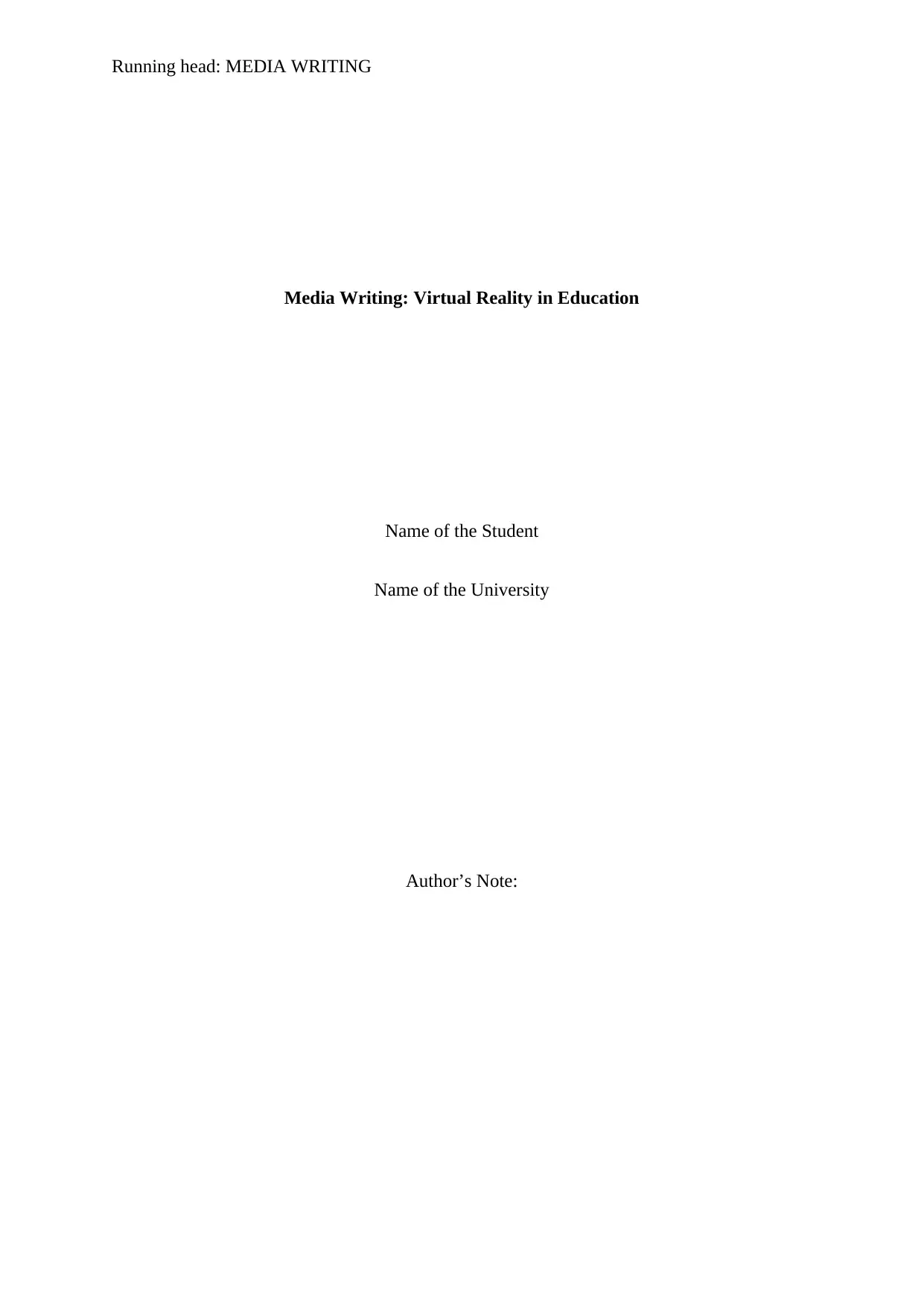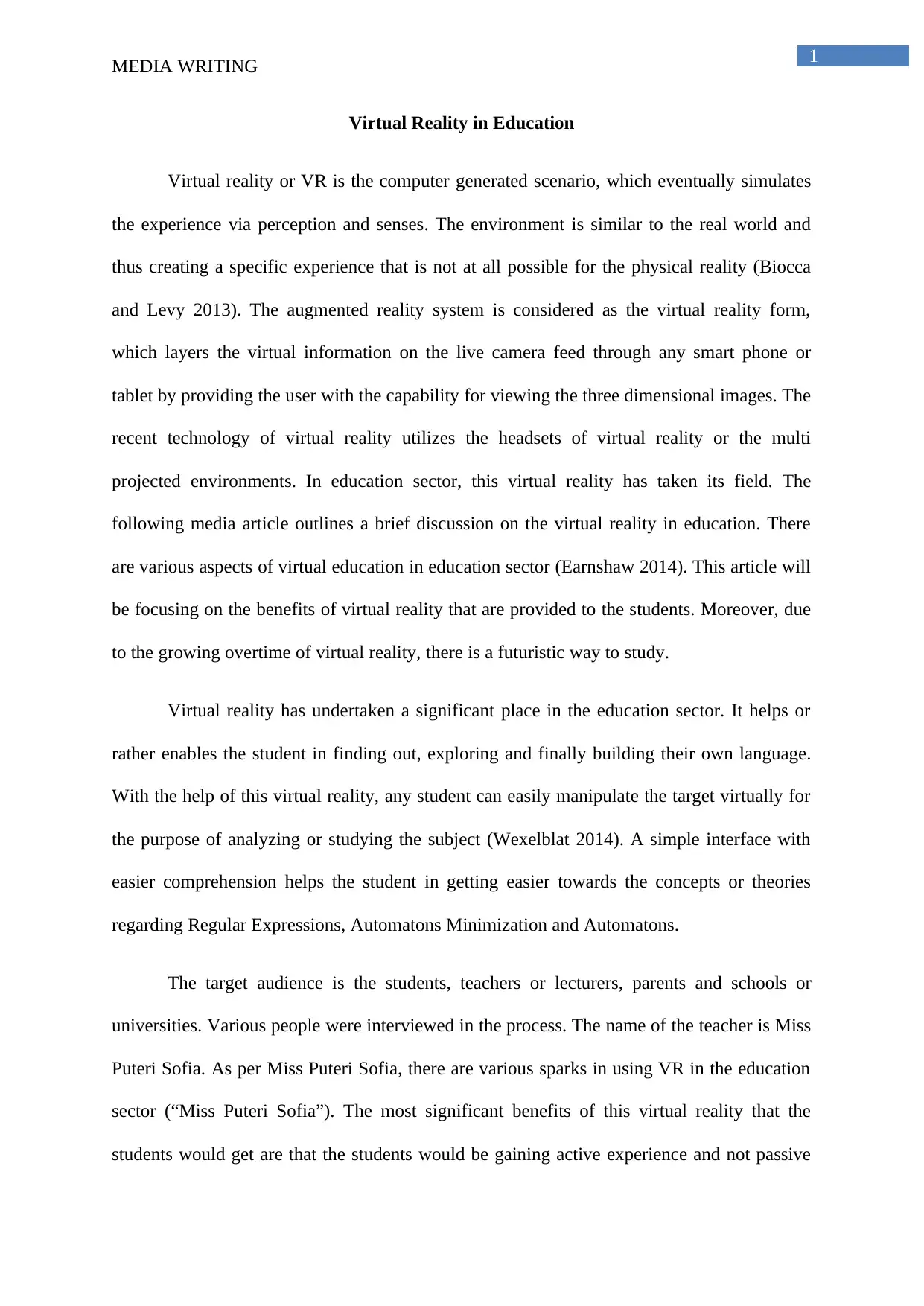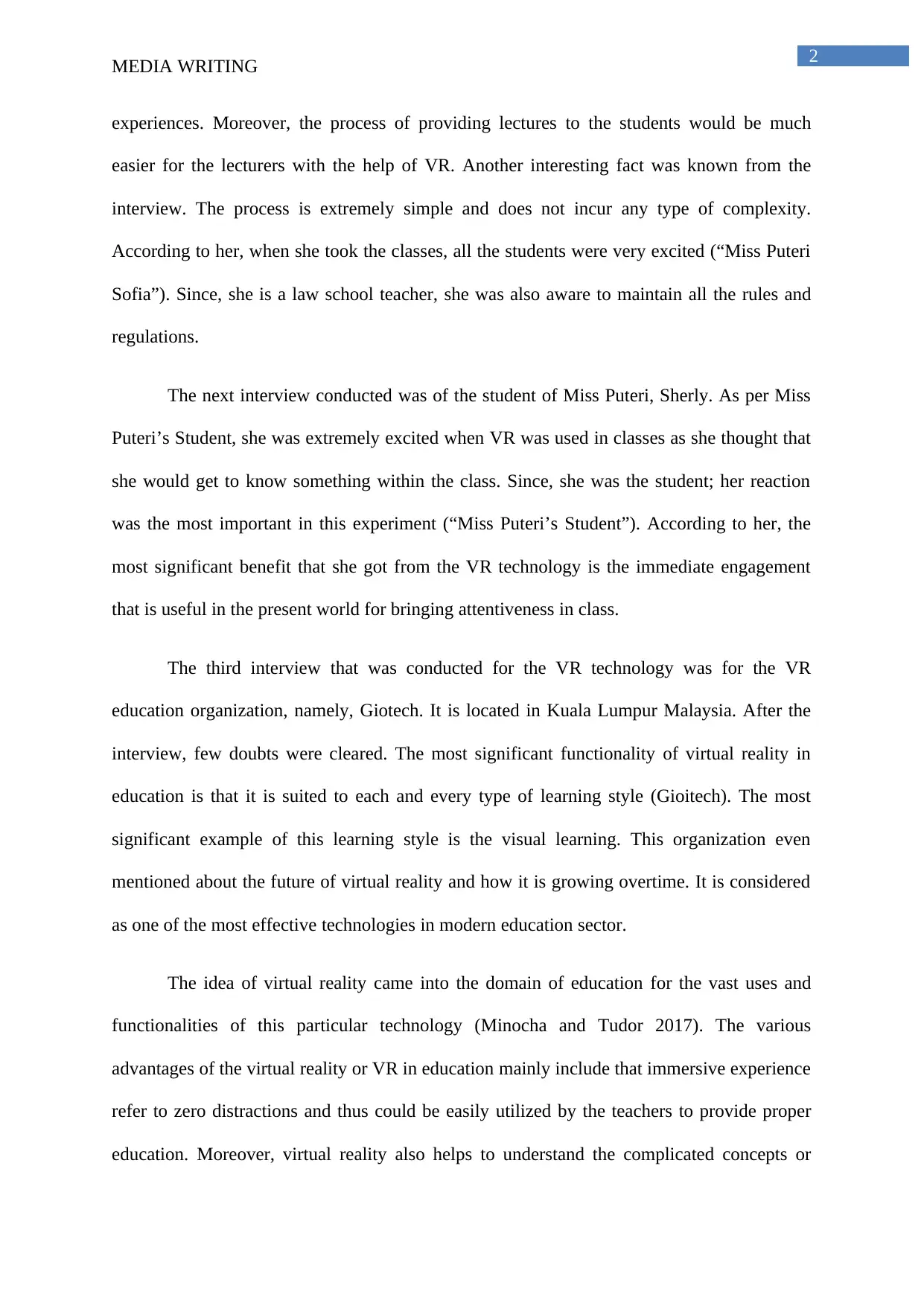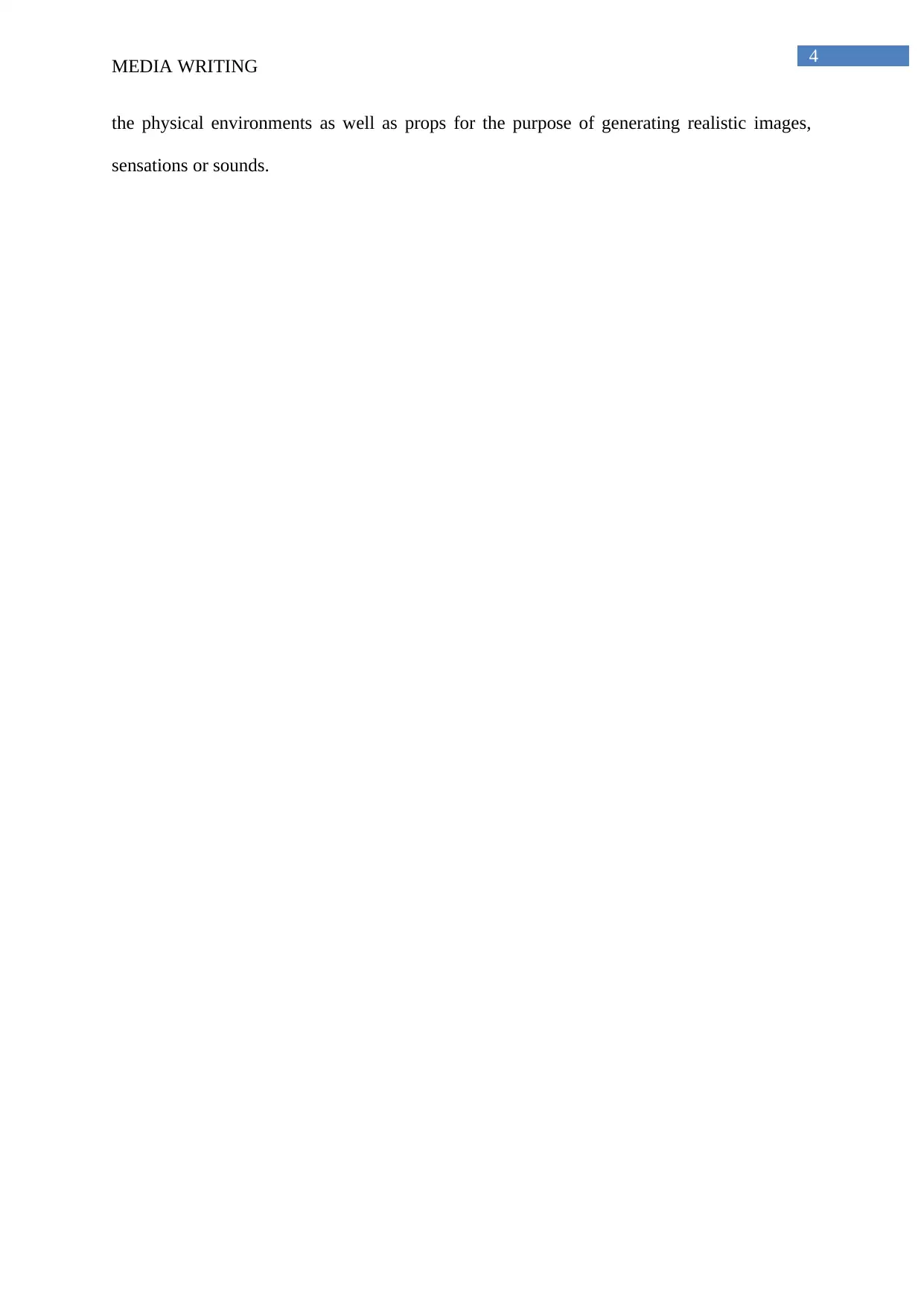Media Writing Report: The Impact of Virtual Reality in Education
VerifiedAdded on 2021/06/16
|6
|1421
|115
Report
AI Summary
This media writing report examines the growing integration of virtual reality (VR) in the education sector. The report defines VR and its simulation capabilities, highlighting its potential to create immersive and engaging learning experiences. It discusses various aspects of VR in education, focusing on the benefits for students, such as active learning, easier comprehension of complex theories, and enhanced exploration capabilities. The report also presents interviews with educators and students, showcasing the positive impacts of VR on student engagement and learning outcomes. Furthermore, it addresses blended learning approaches and the importance of VR in the context of the digital generation. The report concludes that VR is an advanced method to simulate computer-generated scenarios, which benefits students and enhances the futuristic approach to learning. References to relevant academic sources are also included.

Running head: MEDIA WRITING
Media Writing: Virtual Reality in Education
Name of the Student
Name of the University
Author’s Note:
Media Writing: Virtual Reality in Education
Name of the Student
Name of the University
Author’s Note:
Paraphrase This Document
Need a fresh take? Get an instant paraphrase of this document with our AI Paraphraser

1
MEDIA WRITING
Virtual Reality in Education
Virtual reality or VR is the computer generated scenario, which eventually simulates
the experience via perception and senses. The environment is similar to the real world and
thus creating a specific experience that is not at all possible for the physical reality (Biocca
and Levy 2013). The augmented reality system is considered as the virtual reality form,
which layers the virtual information on the live camera feed through any smart phone or
tablet by providing the user with the capability for viewing the three dimensional images. The
recent technology of virtual reality utilizes the headsets of virtual reality or the multi
projected environments. In education sector, this virtual reality has taken its field. The
following media article outlines a brief discussion on the virtual reality in education. There
are various aspects of virtual education in education sector (Earnshaw 2014). This article will
be focusing on the benefits of virtual reality that are provided to the students. Moreover, due
to the growing overtime of virtual reality, there is a futuristic way to study.
Virtual reality has undertaken a significant place in the education sector. It helps or
rather enables the student in finding out, exploring and finally building their own language.
With the help of this virtual reality, any student can easily manipulate the target virtually for
the purpose of analyzing or studying the subject (Wexelblat 2014). A simple interface with
easier comprehension helps the student in getting easier towards the concepts or theories
regarding Regular Expressions, Automatons Minimization and Automatons.
The target audience is the students, teachers or lecturers, parents and schools or
universities. Various people were interviewed in the process. The name of the teacher is Miss
Puteri Sofia. As per Miss Puteri Sofia, there are various sparks in using VR in the education
sector (“Miss Puteri Sofia”). The most significant benefits of this virtual reality that the
students would get are that the students would be gaining active experience and not passive
MEDIA WRITING
Virtual Reality in Education
Virtual reality or VR is the computer generated scenario, which eventually simulates
the experience via perception and senses. The environment is similar to the real world and
thus creating a specific experience that is not at all possible for the physical reality (Biocca
and Levy 2013). The augmented reality system is considered as the virtual reality form,
which layers the virtual information on the live camera feed through any smart phone or
tablet by providing the user with the capability for viewing the three dimensional images. The
recent technology of virtual reality utilizes the headsets of virtual reality or the multi
projected environments. In education sector, this virtual reality has taken its field. The
following media article outlines a brief discussion on the virtual reality in education. There
are various aspects of virtual education in education sector (Earnshaw 2014). This article will
be focusing on the benefits of virtual reality that are provided to the students. Moreover, due
to the growing overtime of virtual reality, there is a futuristic way to study.
Virtual reality has undertaken a significant place in the education sector. It helps or
rather enables the student in finding out, exploring and finally building their own language.
With the help of this virtual reality, any student can easily manipulate the target virtually for
the purpose of analyzing or studying the subject (Wexelblat 2014). A simple interface with
easier comprehension helps the student in getting easier towards the concepts or theories
regarding Regular Expressions, Automatons Minimization and Automatons.
The target audience is the students, teachers or lecturers, parents and schools or
universities. Various people were interviewed in the process. The name of the teacher is Miss
Puteri Sofia. As per Miss Puteri Sofia, there are various sparks in using VR in the education
sector (“Miss Puteri Sofia”). The most significant benefits of this virtual reality that the
students would get are that the students would be gaining active experience and not passive

2
MEDIA WRITING
experiences. Moreover, the process of providing lectures to the students would be much
easier for the lecturers with the help of VR. Another interesting fact was known from the
interview. The process is extremely simple and does not incur any type of complexity.
According to her, when she took the classes, all the students were very excited (“Miss Puteri
Sofia”). Since, she is a law school teacher, she was also aware to maintain all the rules and
regulations.
The next interview conducted was of the student of Miss Puteri, Sherly. As per Miss
Puteri’s Student, she was extremely excited when VR was used in classes as she thought that
she would get to know something within the class. Since, she was the student; her reaction
was the most important in this experiment (“Miss Puteri’s Student”). According to her, the
most significant benefit that she got from the VR technology is the immediate engagement
that is useful in the present world for bringing attentiveness in class.
The third interview that was conducted for the VR technology was for the VR
education organization, namely, Giotech. It is located in Kuala Lumpur Malaysia. After the
interview, few doubts were cleared. The most significant functionality of virtual reality in
education is that it is suited to each and every type of learning style (Gioitech). The most
significant example of this learning style is the visual learning. This organization even
mentioned about the future of virtual reality and how it is growing overtime. It is considered
as one of the most effective technologies in modern education sector.
The idea of virtual reality came into the domain of education for the vast uses and
functionalities of this particular technology (Minocha and Tudor 2017). The various
advantages of the virtual reality or VR in education mainly include that immersive experience
refer to zero distractions and thus could be easily utilized by the teachers to provide proper
education. Moreover, virtual reality also helps to understand the complicated concepts or
MEDIA WRITING
experiences. Moreover, the process of providing lectures to the students would be much
easier for the lecturers with the help of VR. Another interesting fact was known from the
interview. The process is extremely simple and does not incur any type of complexity.
According to her, when she took the classes, all the students were very excited (“Miss Puteri
Sofia”). Since, she is a law school teacher, she was also aware to maintain all the rules and
regulations.
The next interview conducted was of the student of Miss Puteri, Sherly. As per Miss
Puteri’s Student, she was extremely excited when VR was used in classes as she thought that
she would get to know something within the class. Since, she was the student; her reaction
was the most important in this experiment (“Miss Puteri’s Student”). According to her, the
most significant benefit that she got from the VR technology is the immediate engagement
that is useful in the present world for bringing attentiveness in class.
The third interview that was conducted for the VR technology was for the VR
education organization, namely, Giotech. It is located in Kuala Lumpur Malaysia. After the
interview, few doubts were cleared. The most significant functionality of virtual reality in
education is that it is suited to each and every type of learning style (Gioitech). The most
significant example of this learning style is the visual learning. This organization even
mentioned about the future of virtual reality and how it is growing overtime. It is considered
as one of the most effective technologies in modern education sector.
The idea of virtual reality came into the domain of education for the vast uses and
functionalities of this particular technology (Minocha and Tudor 2017). The various
advantages of the virtual reality or VR in education mainly include that immersive experience
refer to zero distractions and thus could be easily utilized by the teachers to provide proper
education. Moreover, virtual reality also helps to understand the complicated concepts or
⊘ This is a preview!⊘
Do you want full access?
Subscribe today to unlock all pages.

Trusted by 1+ million students worldwide

3
MEDIA WRITING
theories. The next benefit of virtual reality in education is that it helps to explore with hands
for the proper retention and learning (Freina and Ott 2015). Due to these important as well as
significant advantages, virtual reality is well accepted by all users and hence is becoming
popular day by day. Apart from the students, the lecturers are also benefitted from the
technology. The digital generation is highly affected with this virtual reality technology. The
students are more clued up regarding this technology from their parents and are thus using it
on regular basis. Each and every social medium like Facebook, Twitter are operated from the
applications of mobile phones, computer games or any other are forming a larger part of the
lifestyle of any teenager and hence the teachers are always aware of the reliance or utilization
of technology (Wu et al. 2013).
Virtual reality is extremely important for using it in the field of learning. One of the
most significant approaches within this virtual reality is blended learning, where all the
learning approaches is amalgamated together (Merchant et al. 2014). It eventually means that
the mixture of computer aided learning like the virtual reality system with the traditional
learning form. The hybrid approach is for meeting all the requirements of all the students,
irrespective of the learning styles. The traditional ways of education is broken with the help
of virtual reality and thus the futuristic way of studying is solely enhanced (Häfner, Häfner
and Ovtcharova 2013).
Therefore, from the above discussion, it is concluded that virtual reality is the most
advanced method to simulate a specific computer generated scenario. This scenario is
checked with the help of perception as well as senses. This type of environment is like the
real world environment or could be fantastical. This particular environment is extremely
important for the education sector and thus the students are explicitly benefitted from this
technology. The current technology of the virtual reality has various uses in headsets of
virtual reality or environments of multi projects. These environments are combined with all
MEDIA WRITING
theories. The next benefit of virtual reality in education is that it helps to explore with hands
for the proper retention and learning (Freina and Ott 2015). Due to these important as well as
significant advantages, virtual reality is well accepted by all users and hence is becoming
popular day by day. Apart from the students, the lecturers are also benefitted from the
technology. The digital generation is highly affected with this virtual reality technology. The
students are more clued up regarding this technology from their parents and are thus using it
on regular basis. Each and every social medium like Facebook, Twitter are operated from the
applications of mobile phones, computer games or any other are forming a larger part of the
lifestyle of any teenager and hence the teachers are always aware of the reliance or utilization
of technology (Wu et al. 2013).
Virtual reality is extremely important for using it in the field of learning. One of the
most significant approaches within this virtual reality is blended learning, where all the
learning approaches is amalgamated together (Merchant et al. 2014). It eventually means that
the mixture of computer aided learning like the virtual reality system with the traditional
learning form. The hybrid approach is for meeting all the requirements of all the students,
irrespective of the learning styles. The traditional ways of education is broken with the help
of virtual reality and thus the futuristic way of studying is solely enhanced (Häfner, Häfner
and Ovtcharova 2013).
Therefore, from the above discussion, it is concluded that virtual reality is the most
advanced method to simulate a specific computer generated scenario. This scenario is
checked with the help of perception as well as senses. This type of environment is like the
real world environment or could be fantastical. This particular environment is extremely
important for the education sector and thus the students are explicitly benefitted from this
technology. The current technology of the virtual reality has various uses in headsets of
virtual reality or environments of multi projects. These environments are combined with all
Paraphrase This Document
Need a fresh take? Get an instant paraphrase of this document with our AI Paraphraser

4
MEDIA WRITING
the physical environments as well as props for the purpose of generating realistic images,
sensations or sounds.
MEDIA WRITING
the physical environments as well as props for the purpose of generating realistic images,
sensations or sounds.

5
MEDIA WRITING
References
Biocca, F. and Levy, M.R. eds., 2013. Communication in the age of virtual reality.
Routledge.
Earnshaw, R.A. ed., 2014. Virtual reality systems. Academic press.
Freina, L. and Ott, M., 2015, January. A literature review on immersive virtual reality in
education: state of the art and perspectives. In The International Scientific Conference
eLearning and Software for Education (Vol. 1, p. 133). " Carol I" National Defence
University.
Häfner, P., Häfner, V. and Ovtcharova, J., 2013. Teaching methodology for virtual reality
practical course in engineering education. Procedia Computer Science, 25, pp.251-260.
Merchant, Z., Goetz, E.T., Cifuentes, L., Keeney-Kennicutt, W. and Davis, T.J., 2014.
Effectiveness of virtual reality-based instruction on students' learning outcomes in K-12 and
higher education: A meta-analysis. Computers & Education, 70, pp.29-40.
Minocha, S. and Tudor, A.D., 2017. Virtual reality in education.
Wexelblat, A. ed., 2014. Virtual reality: applications and explorations. Academic Press.
Wu, H.K., Lee, S.W.Y., Chang, H.Y. and Liang, J.C., 2013. Current status, opportunities and
challenges of augmented reality in education. Computers & education, 62, pp.41-49.
MEDIA WRITING
References
Biocca, F. and Levy, M.R. eds., 2013. Communication in the age of virtual reality.
Routledge.
Earnshaw, R.A. ed., 2014. Virtual reality systems. Academic press.
Freina, L. and Ott, M., 2015, January. A literature review on immersive virtual reality in
education: state of the art and perspectives. In The International Scientific Conference
eLearning and Software for Education (Vol. 1, p. 133). " Carol I" National Defence
University.
Häfner, P., Häfner, V. and Ovtcharova, J., 2013. Teaching methodology for virtual reality
practical course in engineering education. Procedia Computer Science, 25, pp.251-260.
Merchant, Z., Goetz, E.T., Cifuentes, L., Keeney-Kennicutt, W. and Davis, T.J., 2014.
Effectiveness of virtual reality-based instruction on students' learning outcomes in K-12 and
higher education: A meta-analysis. Computers & Education, 70, pp.29-40.
Minocha, S. and Tudor, A.D., 2017. Virtual reality in education.
Wexelblat, A. ed., 2014. Virtual reality: applications and explorations. Academic Press.
Wu, H.K., Lee, S.W.Y., Chang, H.Y. and Liang, J.C., 2013. Current status, opportunities and
challenges of augmented reality in education. Computers & education, 62, pp.41-49.
⊘ This is a preview!⊘
Do you want full access?
Subscribe today to unlock all pages.

Trusted by 1+ million students worldwide
1 out of 6
Your All-in-One AI-Powered Toolkit for Academic Success.
+13062052269
info@desklib.com
Available 24*7 on WhatsApp / Email
![[object Object]](/_next/static/media/star-bottom.7253800d.svg)
Unlock your academic potential
Copyright © 2020–2025 A2Z Services. All Rights Reserved. Developed and managed by ZUCOL.